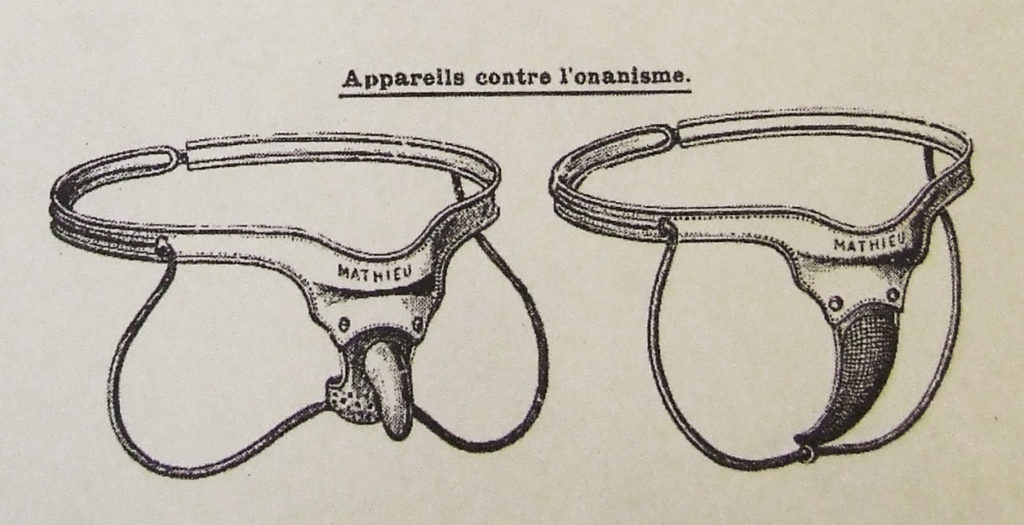
Not everyone is on board with the health benefits of masturbation. The fact that we get to talk about it at all nowadays is an important advancement. Society wasn’t always this open minded about self-pleasure but like most events in history it’s tolerance has ebbed and flowed depending on the culture and the time. In some ancient cultures, and even a few more modern ones, masturbation is thought of as a natural and normal part of life. There was a fervor against masturbation in the 18th, 19th century and early 20th century when not only was it a religious issue but a medical one. During this time medicine was still nothing much more than a guessing game laden with folk wisdom and very little actual science. Many treatises were written about the perils of masturbation. It was said to lead to a variety of maladies of the mind and body and often thought of as a disease that could have fatal consequences. Even naturally occurring nocturnal emissions were diagnosed as the disease Spermatorrhea. The Victorian era saw a plethora of anti-masturbation and nocturnal emission prevention device patents. Hard to believe these cruel and often painful devices were ever created much less used.
Jaws That Bite, Claws That Catch
Pointed teeth and sharp clamps seemed to be a popular Victorian idea for preventing erections which might lead to ejaculation or worse yet lure you to touch yourself then lead to ejaculation or orgasm. There were a variety of sheaths that used tiny teeth to wake the wearer in the hopes of stopping any potential night emissions. One of the most popular among anti-masturbation research articles is the Spermatorrhea ring or Jugum Penis. It has a teeth filled trap that went around the penis and was clipped so it was secured at the base. This device was sure to wake you if getting aroused during sleep thus deterring nocturnal emissions and masturbation. Not all painful measures used pointed teeth but other ways to use pain to wake the wearer. The Bowden device was a metal cover that was slipped over the penis and clipped to the pubic hairs. If you became aroused, it ripped out pubic hairs as a sure fire way to wake you. The pain of tearing out pubes would put a damper on that impending erection too.
Sheaths and Trusses
There were a variety of sheaths and trusses given patents in the Victorian Era. Sheaths seemed more of a rarity with trusses, basically male chastity belts, being more common. The goal was to either prevent your member from growing thus preventing the possibility of ejaculation and/or prevent yourself from touching and manipulating said erect penis. One example is a mechanical sheath created by Raphael Sonn in 1906. This tight metal sheath had a close enough fit that removal would cause intense pain or mutilation. It could only be opened with a tiny key. Harvey Stephenson’s Spermatic Truss patented in 1876 was a device that strapped the penis into a pouch that was then strapped to the leg to prevent erection. A later version of this device didn’t strap the penis to the leg but instead provided a spike-lined pouch to deter erections. Cage devices that were even recommended by medical journals may not necessarily have prevented erections but prevented being about to do anything with them. Fitting over the penis the cage would prevent masturbation by preventing the hand from coming into contact with the penis. You could also get a metal covering for the penis and testicles, sort of a steel codpiece worn under clothes, was a way to prevent the wearer from getting aroused or touching themselves. Examples of these metal casings show holes for urination and a bit of air circulation. It looks like they attached to your waistband or may have had a waistband of their own.
Shock Therapy and Alarming Options
Albert Todd created a device in 1903 that you slipped your member and testicles into and if your penis grew beyond a certain length would trigger an electrical discharge to the testicles. This metal sheath with a series of coils attached to a harness was designed to be worn at all times. Other devices used electricity to trigger an alarm system. A cord or wire would be placed on the penis so that an alarm was triggered if there was growth or movement during the night. This was often marketed as a way for parents to monitor their young boys. In 1899 George Dudley came up with a device that when triggered by an impending erection rang a bell to wake the wearer. Joseph Lees created a harness in 1989 that had an “alarm loud enough to waken even a heavy sleeper.” Lees also created a kinder and gentler version of this device that used “soothing classical music or other pleasing medium” by attaching a gramophone to the device.
Cold Showers, Hot PJs, and Armored Bodysuits
Frank Orth developed a “cooling” device in 1893. Putting on these cooling underpants the penis was put into a pocket that was between two levers. Should an erection happen, a small fan would be activated to send cold air through tubes to shrink the erection. There was also a version that used cold water to cool the organ so that “the erection subsides and no discharge occurs.” Basically, it’s the Underoos version of a cold shower. There were other devices that tried to keep not only your body cool but also the distracting fabric of your bedclothes away from your genitals. An odd device that hooks to your raised knees created a tent of sorts to keep fabric away from your groin. As if that wasn’t enough, full body coverings were used to prevent wandering hands from getting to genitals. Ellen E Perkins developed “sexual armor” in 1907, a cloth bodysuit with metal plates that had locking zippers. Her device was created because “It is a deplorable but well known fact that one of the most common causes of insanity, imbecility and feeblemindedness, especially in youth, is due to masturbation or self abuse.” It saddens me to see this device was marketed for the institutionalized, more specifically mental patients, as a way to stop them from touching themselves. Such cruelty.
An Era Devoted to Extreme Anti-Masturbation
The list of anti-masturbation and excessive emissions techniques seems endless while researching this era. At its peak, they used everything from circumcision without an anesthetic, metal staples, exercise, electric shock, extreme fear tactics and modified diets to cure this terrible disease that was ruining physical and mental health. Once we get into the 1930’s and 40’s these extreme ideas start to wane. The Kinsey era arrives and we start to understand that sexual bodily functions are normal and healthy. During the Victorian Era, women had their own brand anti-masturbation devices and techniques geared towards them too but that’s an article for another day.
Last modified: November 13, 2018


“During the Victorian Era, even though their doctors were attempting to cure Hysteria with manual stimulation and vibrators, it was not thought of as bringing on orgasms for women.”
Yeah, because that would not be welcomed news for the clueless, floudering doctors, or for those ladies’ disapproving familiy members, now would it? Hopefully they’ve made the best out of those awful “treatments”. 😛
Also, for some reason I’m having mental “crossovers” to Hannibal appreciating the medieval torture device gallery. xD
[…] that time believed the art of self-pleasure was highly dangerous to your health (check out these painful looking anti-masturbation devices – moment of silence for all the teens during 1840 to 1900). However, Michel Foucault famously […]
Can somone tell me why the name Mathieu is on them. It’s my son’s name and I’m curious.
The device comes from Louis Mathieu’s company, Maison Mathieu. Louis Mathieu was a manufacturer of surgical and medical equipment in the 19th century. His son continued to run the company after his death.